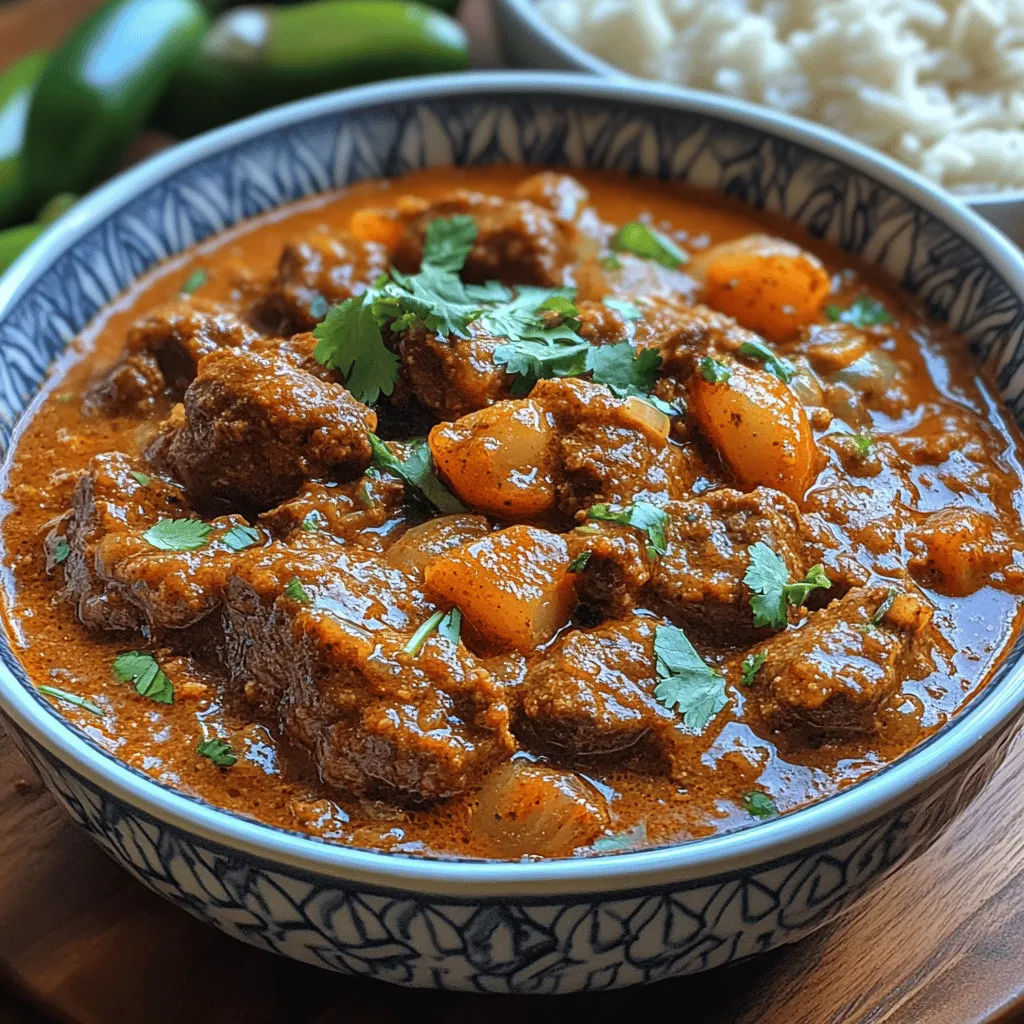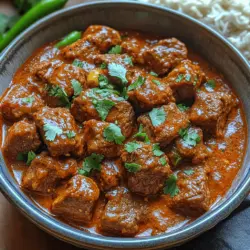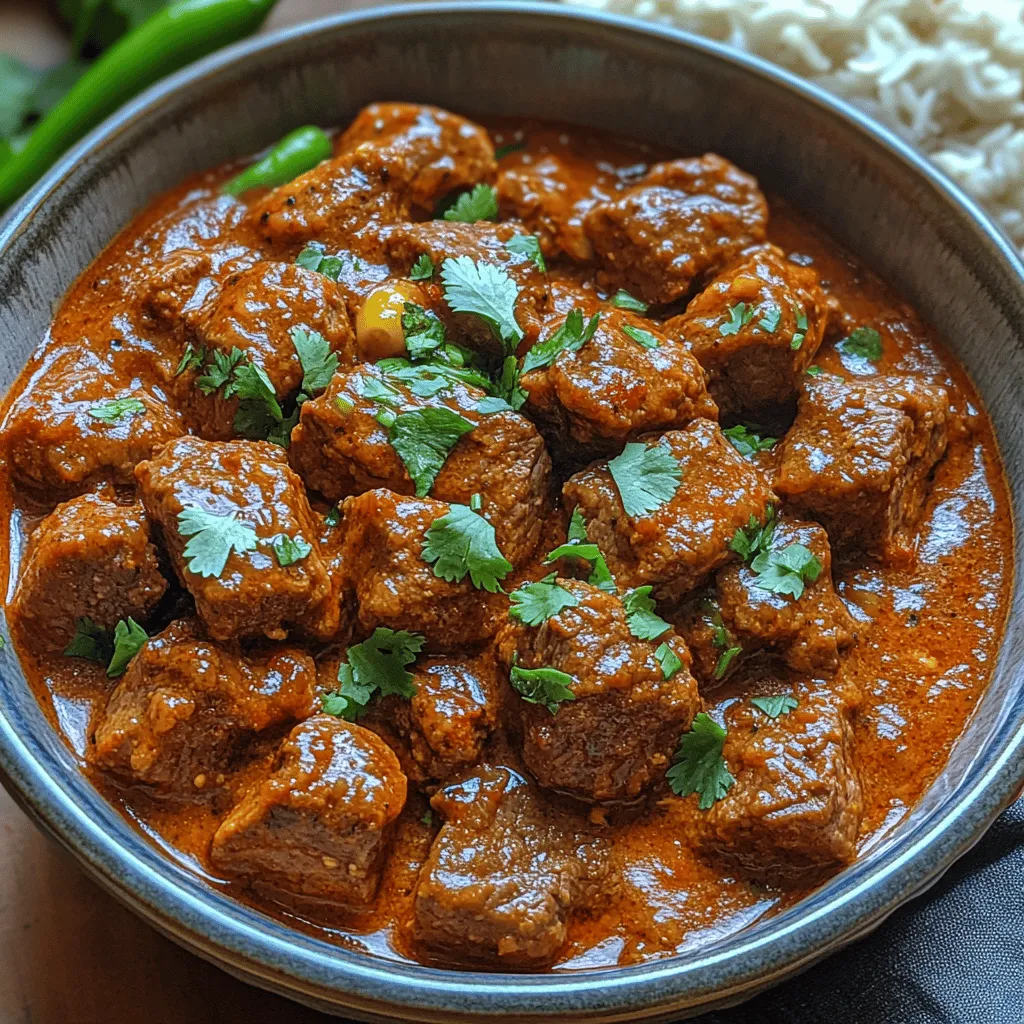Introduction
Beef Vindaloo, a dish that evokes a rich tapestry of flavors and traditions, is a traditional Indian recipe that has garnered immense popularity across the globe. Hailing from the coastal state of Goa, this dish is renowned for its spicy and tangy flavor profile, which tantalizes the taste buds and leaves an indelible mark on anyone who indulges in its bold taste. The roots of Beef Vindaloo can be traced back to the Portuguese colonization of India, where the dish has evolved over centuries, melding various culinary influences into a unique and delicious offering that is cherished by many.
The allure of Beef Vindaloo lies not only in its complex flavors but also in its ability to bring warmth and comfort to the table. The dish is characterized by a robust blend of spices, complemented by the sharpness of vinegar and a hint of sweetness. This creates a harmonious balance that makes it a standout choice for dinner parties and family gatherings alike. However, to achieve an authentic Beef Vindaloo, the importance of using quality ingredients cannot be overstated. Fresh, high-quality components are fundamental to replicating the true essence of this dish, ensuring that each bite is packed with flavor.
Understanding Beef Vindaloo
Historical Background
The history of Beef Vindaloo is as rich as its flavor. Originating in Goa, India, the dish is a result of the Portuguese influence on Indian cuisine. The name “Vindaloo” itself is derived from the Portuguese dish “Carne de Vinha d’Alhos,” which translates to “meat marinated in wine and garlic.” When the Portuguese settled in Goa, they adapted this recipe to incorporate local ingredients, leading to the creation of the tangy and spicy dish we know today.
The use of vinegar, a key ingredient in Vindaloo, reflects the Portuguese culinary tradition of preserving meats. Over time, Indian cooks began to adapt the recipe further, incorporating local spices such as cumin, coriander, and mustard seeds, along with the fiery heat from various types of chilies. This transformation not only enhanced the dish’s flavor but also made it a symbol of the fusion between Portuguese and Indian culinary practices.
Flavor Profile
At the heart of Beef Vindaloo lies its signature tanginess and heat. The dish’s vibrant flavor profile is achieved through a careful balance of ingredients. The use of vinegar not only tenderizes the meat but also adds a distinct sharpness that cuts through the richness of the beef. This acidity is complemented by the warmth of spices and the heat from chilies, creating a multi-layered taste that is both complex and satisfying.
In addition to the heat, the dish often features a subtle sweetness, which can be derived from ingredients like jaggery or the natural sweetness of the beef itself. It’s the interplay of these flavors—spicy, tangy, sweet, and savory—that makes Beef Vindaloo a beloved dish around the world.
Variations of Vindaloo
While Beef Vindaloo is the most recognized version, variations of this dish can be found across different cultures and regions. In Goa, pork is often used as a base, reflecting local preferences, while chicken Vindaloo has also gained popularity due to its quicker cooking time and lighter flavor. Each variation maintains the core principles of the dish—spiciness and tanginess—but may differ in terms of ingredients and preparation methods.
Outside of India, Vindaloo has found its way into various cuisines, adapting to local tastes and ingredients. For example, in some Western adaptations, the heat level may be dialed down, or additional ingredients like coconut milk may be introduced to create a creamier texture. These variations showcase the versatility of Vindaloo and its ability to evolve while retaining its foundational characteristics.
Ingredients Breakdown
Beef: The Star of the Dish
Choosing the right cut of beef is crucial for a successful Beef Vindaloo. Chuck and brisket are the preferred choices, as they have the right balance of meat and fat, which ensures tenderness during the slow cooking process. Chuck is particularly advantageous due to its marbling, which renders down and enriches the sauce, while brisket offers a robust flavor that holds up well against the bold spices used in this dish.
When selecting beef, look for cuts that are deep red and well-marbled, as this indicates freshness and quality. For the best results, consider purchasing beef from a local butcher, where you can inquire about the sourcing and handling of the meat.
Aromatics: Onions, Garlic, and Ginger
The foundation of any great curry lies in its aromatics, and Beef Vindaloo is no exception. Onions, garlic, and ginger work in harmony to build a robust flavor base. The onions are typically sautéed until golden brown, which adds a natural sweetness and depth to the dish. Garlic and ginger, both known for their aromatic qualities, enhance the overall flavor and bring warmth to the dish.
For optimal flavor, use fresh garlic and ginger rather than pre-minced versions. The freshness of these ingredients plays a significant role in the final taste, ensuring that the dish is fragrant and inviting.
Chilies: Controlling the Heat
Chilies are the heart of the heat in Beef Vindaloo. The type of chili you choose can significantly impact the dish’s spice level. Dried red chilies such as Kashmiri or Byadgi are commonly used in traditional recipes, as they provide a vibrant color and medium heat without being overwhelmingly spicy. If you prefer a higher heat level, you can incorporate additional varieties like dried Thai bird chilies or use fresh green chilies for a different flavor profile.
To adjust the heat to your personal preference, consider the following tips:
– Remove the seeds from the chilies before grinding, as this can reduce the heat.
– Start with fewer chilies, and taste the dish as it cooks, adding more if desired.
– Balance the heat with a touch of sweetness or additional vinegar to create a well-rounded flavor.
Spices: Freshly Toasted for Maximum Flavor
The spices used in Beef Vindaloo are what truly elevate the dish. A blend of spices such as cumin, coriander, turmeric, and mustard seeds creates a complex flavor profile that is essential for achieving authenticity. To maximize the flavor, it is crucial to toast the spices before grinding them, as this process releases their natural oils and enhances their aromatic qualities.
To toast spices, simply heat a dry skillet over medium heat, add the whole spices, and stir frequently until fragrant. This usually takes just a few minutes, so be vigilant to avoid burning. Once toasted, the spices can be ground into a fine powder, ready to be incorporated into your Vindaloo marinade.
Vinegar and Tamarind: Achieving Tanginess
Vinegar is a key player in the flavor profile of Beef Vindaloo, contributing to its signature tanginess. Traditional recipes often use cane vinegar, which provides a sharp, clean acidity that enhances the overall taste of the dish. If cane vinegar is not available, apple cider vinegar can be used as a substitute, though it may impart a slightly different flavor.
In addition to vinegar, tamarind can be included to add another layer of tanginess. Tamarind paste provides a unique sourness that complements the heat of the chilies, creating a well-balanced dish. When using tamarind, it is important to dissolve it in a bit of warm water before adding it to the curry to ensure even distribution.
Fresh Cilantro: The Finishing Touch
To garnish Beef Vindaloo, fresh cilantro is essential. Not only does it add a pop of color, but it also brings a fresh, herbaceous note that balances the richness of the dish. When serving, sprinkle chopped cilantro over the top just before presenting the dish, allowing its vibrant flavor to shine through and enhance the overall experience.
Preparation Steps for Spicy & Tangy Beef Vindaloo
Marinating the Beef
Marination is a crucial step in preparing Beef Vindaloo, as it allows the meat to absorb the flavors of the spices and vinegar. To begin, cut the beef into bite-sized pieces and place it in a large bowl. Prepare a marinade using a blend of ground spices, minced garlic, ginger, and vinegar, ensuring the beef is well-coated.
Cover the bowl with plastic wrap and refrigerate for at least 4 hours, or ideally overnight. This not only infuses the meat with flavor but also tenderizes it, resulting in a melt-in-your-mouth texture once cooked. If time is of the essence, even a minimum of 30 minutes can yield noticeable improvements in flavor.
Toasting and Grinding Spices
As previously mentioned, toasting and grinding spices is vital for maximizing flavor. Begin by measuring out the whole spices you plan to use, and heat a dry skillet over medium heat. Add the spices and toast them for a few minutes until fragrant. Once toasted, allow them to cool slightly before transferring them to a spice grinder or mortar and pestle to grind into a fine powder.
This freshly ground spice blend will form the aromatic backbone of your Beef Vindaloo, enriching the dish with its robust flavors. When added to the marinade, these spices create a depth that is simply unmatched by pre-ground varieties.
By following these initial steps of marinating the beef and preparing your spices, you lay the groundwork for an authentic and delicious Beef Vindaloo that is sure to impress your family and friends. The next stages of cooking will build upon this foundation, resulting in a dish that is bursting with flavor and showcases the vibrant culinary heritage of Indian cuisine.

Sautéing the Aromatics
To create a flavorful base for your Beef Vindaloo, start with the aromatics: onions, garlic, and ginger. These three ingredients are foundational in many Indian dishes, providing a depth of flavor that enhances the overall taste. Begin by heating oil in a heavy-bottomed pot or Dutch oven over medium heat. Once hot, add finely chopped onions and sauté them until they turn golden brown. This caramelization process is crucial; it releases the natural sugars in the onions, adding sweetness and complexity to the dish.
After the onions have reached the desired color, add minced garlic and ginger. Cook these for an additional minute, stirring continuously to prevent burning. The aromatic combination of onion, garlic, and ginger not only forms the flavor backbone for the vindaloo but also fills your kitchen with a tantalizing scent that will draw everyone to the table.
Browning the Beef
Once the aromatics are ready, it’s time to turn your attention to the beef. Cut your beef into 1-inch cubes, ensuring uniformity for even cooking. The next step is browning the meat in batches. This step is essential as it creates a rich, caramelized surface on the beef, adding a depth of flavor that is vital for a dish like vindaloo.
Make sure the pot is hot enough before adding the beef. If the pot is overcrowded, the meat will steam rather than brown, resulting in a less satisfying texture and flavor. Allow each piece to sear undisturbed for 3-4 minutes before turning to develop a golden crust. After browning, remove the beef from the pot and set it aside. This process not only enhances the taste but also helps in locking in the juices, ensuring the meat remains tender throughout the cooking process.
Incorporating Tomatoes and Spice Mix
With the beef set aside, it’s time to incorporate the tomatoes and the prepared spice mix. The addition of tomatoes serves a dual purpose: they add acidity, which balances the richness of the beef and oil, and they contribute to the sauce’s texture. If you’re using fresh tomatoes, chop them finely and add them to the pot with the sautéed aromatics. If you prefer canned tomatoes, crushed tomatoes work best.
Next, add your spice blend to the mixture. A traditional vindaloo spice mix includes spices like cumin, coriander, turmeric, and, most importantly, a good amount of red chili powder for heat. This is also the stage to add vinegar, which is a hallmark of vindaloo, giving it that characteristic tangy flavor. Stir everything together, allowing the spices to toast slightly in the hot oil; this will release their essential oils and enhance their flavors.
Simmering for Tenderness
Once the tomatoes have cooked down and the mixture is well-combined, it’s time to return the browned beef to the pot. Pour in enough water to cover the beef, typically about 2-3 cups, depending on your desired sauce thickness. Bring the mixture to a gentle boil, then reduce the heat to low, cover the pot, and let it simmer.
The simmering process is crucial for achieving tender beef that melts in your mouth. Allow the vindaloo to simmer for at least 1.5 to 2 hours. Stir occasionally to ensure nothing sticks to the bottom of the pot. As it cooks, the meat will absorb the complex flavors of the spices and aromatics, while the sauce thickens and becomes rich and velvety.
Adjusting Flavor and Texture
After the beef has simmered to tenderness, it’s time for the most important step: tasting and adjusting the seasoning. This is where your personal touch comes into play. You may want to add more salt, a touch of sugar to balance the acidity, or even more chili powder for extra heat. Keep in mind that vindaloo should have a harmonious balance of spicy, tangy, and savory flavors.
If the sauce is too thick for your liking, you can add a bit more water; if it’s too thin, let it simmer uncovered for a few more minutes to reduce. Adjusting the flavors at this stage ensures that your Beef Vindaloo is perfect to your taste and ready to impress anyone who tries it.
Final Presentation
As you near the end of your cooking journey, consider how you want to present your Beef Vindaloo. Presentation can elevate the dining experience dramatically. For garnishing, fresh cilantro is a beautiful and flavorful option. Chop it finely and sprinkle it generously over the dish just before serving.
Serve the vindaloo hot, ideally in a large bowl or on a platter, allowing guests to help themselves. Traditional accompaniments for Beef Vindaloo include fluffy basmati rice, warm naan, or a cooling raita made from yogurt and cucumber, which helps temper the heat of the dish.
Serving Suggestions
When it comes to serving Beef Vindaloo, pairing it with the right sides can enhance the meal’s overall experience. Here are some of the best options:
– Basmati Rice: The fluffy grains of basmati rice serve as a perfect base for soaking up the spicy sauce. You can also infuse the rice with spices like cardamom or cloves for added flavor.
– Naan: Soft and pillowy naan is great for scooping up the vindaloo. You might consider offering garlic naan or butter naan to complement the rich flavors of the dish.
– Raita: A side of cucumber raita adds a refreshing contrast to the heat of the vindaloo. The coolness of yogurt paired with diced cucumber and a sprinkle of cumin provides a delightful balance.
For beverage pairings, consider a chilled white wine like Sauvignon Blanc or a light-bodied red such as Pinot Noir, both of which can complement the spices beautifully. If you prefer non-alcoholic options, a mango lassi or sweetened iced tea can also work wonders.
Health and Nutritional Aspects
Beef Vindaloo is not only a flavorful dish but also offers a range of nutritional benefits. The beef provides high-quality protein, essential for muscle repair and overall health. The spices used in vindaloo, such as turmeric and cumin, are known for their anti-inflammatory properties and potential health benefits.
Turmeric contains curcumin, which has been studied for its antioxidant effects, while cumin aids digestion. The tomatoes add vitamins A and C, along with potassium, making this dish a balanced addition to your diet. However, it’s essential to consider portion sizes, especially given the richness of the dish.
In moderation, Beef Vindaloo can fit into a well-rounded diet, especially when paired with healthier sides like salads or steamed vegetables. The balance of flavors, from the spicy heat to the tangy notes, showcases the unique qualities of Indian cuisine.
Cultural Significance of Beef Vindaloo
Beef Vindaloo holds a special place in Indian culinary tradition, particularly within Goan cuisine. Originally influenced by Portuguese cooking methods, vindaloo has evolved into a beloved dish that reflects the rich tapestry of Indian flavors. Traditionally, it is enjoyed during celebrations and special occasions, symbolizing hospitality and festivity.
In contemporary contexts, this dish has been adapted and embraced by various cultures around the world, with each region adding its own twist. The blend of spices and the cooking techniques used in vindaloo showcase the adaptability and diversity of Indian cuisine, making it a favorite among food enthusiasts globally.
Conclusion
In conclusion, Beef Vindaloo is more than just a meal; it is a testament to the rich culinary heritage of India. Its complex flavors and aromatic spices create a dish that is both comforting and exciting. Whether you are making it for a family dinner or a special occasion, the process of cooking and sharing this dish embodies the joy of home-cooked food.
We encourage you to try making Beef Vindaloo at home to experience the vibrant flavors of authentic Indian cuisine. Cooking is not only about nourishment but also about creating memories with loved ones. So gather your ingredients, follow the steps, and enjoy the process of bringing this delicious dish to life. Your kitchen will soon be filled with the warmth of spices and the joy of shared meals.

